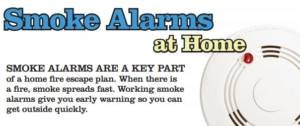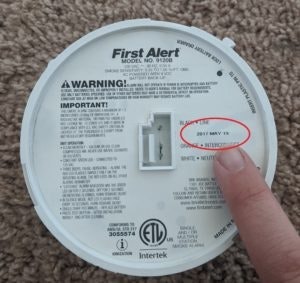Smoke Alarms and Carbon Monoxide Alarm Request Form

Did you know that three out of five home fire deaths were caused by fires in properties with no smoke alarms or smoke alarms that failed to operate? Having proper working smoke alarms in your home saves lives.
All alarms must be installed by SACFD personnel.
Smoke Alarms: Having proper working smoke alarms in your home saves lives. Follow these smoke alarm safety tips :

- Install smoke alarms inside each bedroom, outside each sleeping area, and on every level of the home, including the basement.
- Smoke alarms should be installed at least 10 feet from a cooking appliance to minimize false alarms when cooking.
- Mount smoke alarms high on walls or ceilings (remember, smoke rises). Wall-mounted alarms should be installed not more than 12 inches away from the ceiling( to the top of the alarm).
- For the best protection, install interconnecting smoke alarms. When one smoke alarm sounds, they all sound. Interconnection can be done using hard-wired or wireless technology.
- TEST YOUR SMOKE ALARMS ONCE A MONTH. You want to make sure the battery is properly working. If not, replace the battery!
- Check the manufacture date! Smoke alarms expire and are usually only good for 10 years. Check your manufacturer recommendations for more information.
Carbon Monoxide (CO) alarms are just as important to have in your home. Carbon Monoxide is called "the invisible killer, it is an orderless tasteless gas caused by the incomplete burning of fuels".
- CO alarms should be installed in a central location outside each sleeping area and on every level of the home.
- For best protection, interconnect all CO alarms throughout the home. When one sounds they all sound.
- Test CO alarms at least once a month. You want to make sure the battery is properly working. If not, replace the battery!
- CO alarms expire! Replace them according to the manufacturer’s instructions.
Ways to prevent unwanted CO:
- Warming a vehicle – remove it from the garage immediately after starting it. Make sure the exhaust pipe of any running vehicle is not covered in any way.
- During and after a snowstorm, make sure all vents for the dryer, furnace, stove, and fireplace are clear of snow build-up.
- Use a generator in a well-ventilated location outdoors away from windows, doors, and vent openings.
- Gas or charcoal grills can produce CO. Use them outside only!
Symptoms of CO poisoning: Some symptoms include shortness of breath, nausea, dizziness, lightheadedness, or headaches. High levels of CO can be fatal, causing death within minutes.
If you need assistance in getting or installing your smoke or CO alarms, please contact Anissa Griggs, Public Education Specialist, at 303.288.0835.
